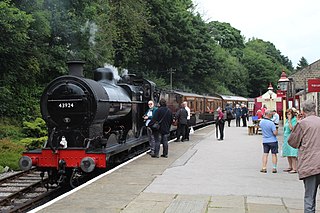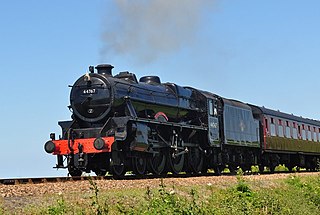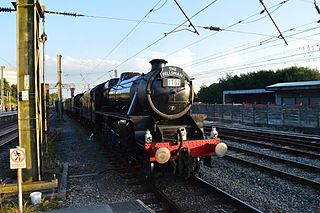
The Keighley & Worth Valley Railway (KWVR) is a 5-mile-long (8 km) heritage railway in the Worth Valley, West Yorkshire, England, which runs from Keighley to Oxenhope. It connects to the National Rail network at Keighley railway station.

The London, Midland and Scottish Railway (LMS) Jubilee Class is a class of steam locomotive designed for main line passenger work. 191 locomotives were built between 1934 and 1936. They were built concurrently with the similar looking LMS Stanier Class 5 4-6-0. They were nicknamed Red Staniers and Jubs.

West Coast Railways (WCR) is a railway spot-hire company and charter train operator based at Carnforth MPD in Lancashire. Using buildings and other facilities previously owned by the Steamtown Carnforth visitor attraction, in June 1998 the company became the first privately owned company to be given a licence as a train operating company.

The BR Standard Class 2 2-6-0 is a class of steam locomotive, one of the British Railways Standard classes of the 1950s. They were physically the smallest of the Standard classes; 65 were built.

The London, Midland and Scottish Railway (LMS) Ivatt Class 2 2-6-2T is a class of light 'mixed-traffic' steam locomotive introduced in 1946.

LMS Princess Coronation Class 46233 Duchess of Sutherland is a steam locomotive built in 1938 for the London, Midland and Scottish Railway (LMS) at Crewe Works to a design by William Stanier. It is a 4-6-2 Pacific locomotive built as part of the LMS Coronation Class for its express passenger services, including the Royal Scot service from London to Glasgow.

London Midland and Scottish Railway (LMS) Stanier Black Five, LMS number 4767, BR number 44767 is a preserved steam locomotive. In preservation it has carried the name George Stephenson though it never bore this in service with British Railways.

The Lancashire and Yorkshire Railway Class 25 is a class of 0-6-0 steam locomotive. They were introduced to the Lancashire and Yorkshire Railway in 1876 by new locomotive superintendent William Barton Wright and 280 were built in total. Of these, 230 were later converted to saddle tanks by John Aspinall, to become L&YR Class 23. They were nicknamed "Ironclads" after the ships of the same name being developed at the time.

LMS Royal Scot Class 6115 Scots Guardsman is a preserved British steam locomotive. Built by the London, Midland and Scottish Railway (LMS) as a member of the Royal Scot Class, it was later operated by British Railways.

London, Midland and Scottish Railway (LMS) Jubilee Class No. 5690Leander is a preserved British steam locomotive.

6201 Princess Elizabeth is a preserved steam locomotive in England. It is one of two preserved LMS Princess Royal Class; the other being 46203 Princess Margaret Rose.

London, Midland and Scottish Railway (LMS) Stanier Class 5 4-6-0 No. 5305 is a preserved British steam locomotive. In preservation, it has carried the name Alderman A.E. Draper, though it never carried this in service. It was named after Albert Draper, the man who rescued the locomotive in his own scrapyard.

Stanier Class 5 4-6-0 5231 is a preserved British steam locomotive. In preservation, it has carried the names 3rd (Volunteer) Battalion The Worcestershire and Sherwood Foresters Regiment and The Sherwood Forester, though it never carried either of these in service.

The NCC Class WT is a class of 2-6-4T steam locomotives built by the Northern Counties Committee's parent company, the London, Midland and Scottish Railway for service in Northern Ireland.

London, Midland and Scottish Railway (LMS) Jubilee Class No. 5699Galatea is a preserved British steam locomotive.

Ingrow (West) railway station is a single-platform station serving the suburb of Ingrow in Keighley, West Yorkshire, England. It is served by the preserved Keighley and Worth Valley Railway. The station is 1.25 miles (2 km) west of Keighley station and 2.25 miles (3.62 km) west of Haworth railway station.

The Fifteen Guinea Special was the last main-line passenger train to be hauled by steam locomotive power on British Rail on 11 August 1968 before the introduction of a steam ban that started the following day, the extra day added to allow for the movement of locomotive BR Standard Class 7 70013 Oliver Cromwell to Bressingham Steam Museum. It was a special rail tour excursion train organised for the occasion from Liverpool Lime Street via Manchester Victoria to Carlisle and back, and was pulled in turn by four steam locomotives during the four legs of the journey. The last scheduled standard gauge steam-hauled passenger services had run on 3 August 1968 from Preston. Steam continued to be used on the narrow gauge Vale of Rheidol Railway under British Rail, which was subsequently privatised in 1989.

LNER Thompson Class B1 No. 61306 Mayflower is a 4-6-0 steam locomotive built in 1948 at the North British Locomotive Company to a design by Edward Thompson. It was employed for hauling mixed traffic trains on British Railways' Eastern, North Eastern, and Scottish Regions until it was bought for preservation in 1967, during which it was renumbered and given its current name.
The Rolling stock of the Keighley & Worth Valley Railway is used on the preserved Keighley & Worth Valley Railway, a 5-mile-long (8 km) branch line that served mills and villages in the Worth Valley and is now a heritage railway line in West Yorkshire, England. It runs from Keighley to Oxenhope. It connects to the national rail network line at Keighley railway station.

LMS Stanier Class 5MT 4932, is a preserved British steam locomotive. It is one of 18 surviving members of the Black 5 class which had 842 members constructed by five manufacturers. 44932 is the sole remaining member of the class which was built at the LMS's Horwich Works.





















